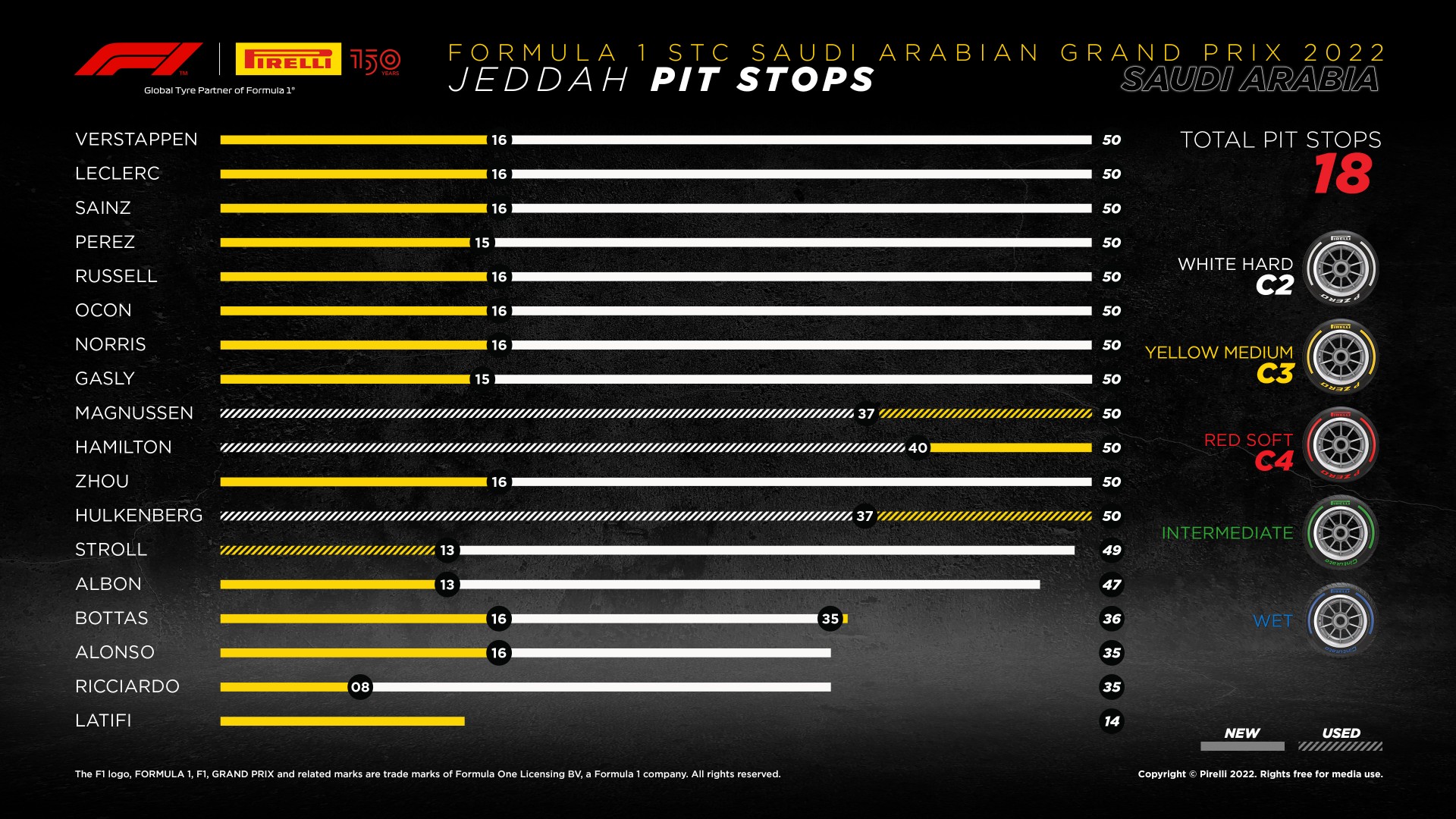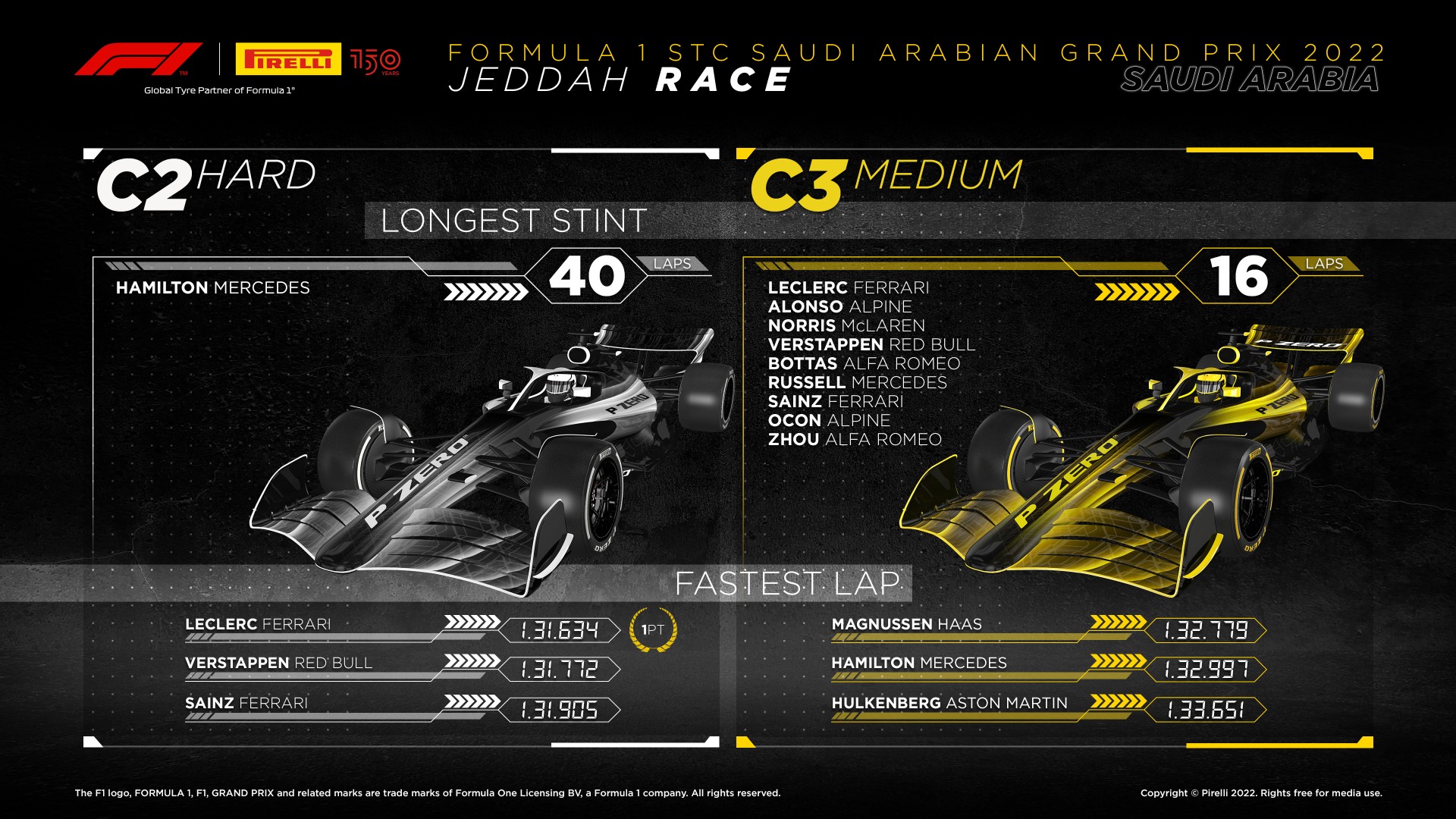2022 Saudi Arabia Grand Prix - Sunday
THE RACE TYRE STORY
- Red Bull driver Max Verstappen won the race with a one-stop strategy, going from P Zero Yellow medium C3 to P Zero White hard C2 under a safety car on lap 16 and then passing Ferrari’s Charles Leclerc – who followed an identical strategy – with three laps to go. Polesitter Sergio Perez led for Red Bull in the early stages but made his pit stop the lap before the safety car came out, which cost him the advantage.
- All the drivers started the race on the Pirelli P Zero Yellow medium, with the exception of Kevin Magnussen (Haas), Lewis Hamilton (Mercedes) and Nico Hulkenberg (Aston Martin), who began on P Zero White hard. They were also the only ones not to stop for fresh tyres under the safety car, although Magnussen and Hulkenberg were able to make their sole stops under a virtual safety car with 13 laps to go before the pitlane was closed. Hamilton stopped three laps later under green flag conditions and finished 10th: one place behind Magnussen.
- Tyre degradation was contained throughout the race for both compounds with some long runs close to 40 laps on the hard compound in particular, which was used by nearly all the drivers for the final stint.
- The race got underway at 8pm local time with quite consistent temperatures of 26 degrees ambient and 34 degrees on track, which dropped only by a couple of degrees during the race.
HOW THE COMPOUNDS MADE THE DIFFERENCE
- HARD C1: The key tyre for the race, with degradation that was close to zero. Leclerc and Red Bull’s Max Verstappen delivered an entertaining final duel for the lead on this compound, with Leclerc obtaining the fastest lap just two from the end. Hamilton completed a 40-lap opening stint on the hard.
- MEDIUM C2: Used by all but three drivers during the opening stint, who then swapped onto it for their final stints. It showed good performance with levels of degradation lower than free practices, allowing the drivers to push hard until the end of the race.
- SOFT C3: Came into its own in qualifying, but the lower degradation offered by the medium and the hard didn’t make the soft a suitable choice for the grand prix.

“Another good night, another good race! Once more, in conditions that were completely different from Bahrain in terms of track layout and characteristics, we saw the latest cars able to follow and pass each other with some great on-track battles: which is down to the new tyres as well. The hard was the key compound to tonight’s race, with strong performance and almost zero degradation, as proved by Charles Leclerc’s fastest lap just two from the end on a well-used set. The medium also had quite low degradation, contributing to the one-stop strategy that we thought would be fastest and helping to deliver an exciting race from start to finish. The fastest race lap was also less than a second slower than the equivalent lap on the same compound last year. So putting all this together, it's clear to see how the new car and tyre package is so far delivering on all the hopes and expectations that we had for this year. Congratulations to Max Verstappen for the hearthbraking victory!”

The 28-lap Formula 2 Feature Race was won by MP Motorsport’s Felipe Drugovich from pole, using the P Zero Red soft to P Zero Yellow medium strategy selected by all but five drivers. The race took place in the warm conditions of the late afternoon, with temperatures of 46 degrees asphalt and 28 degrees ambient. The highest-placed driver to use the alternative strategy (medium to soft) was Hitech’s Dennis Hauger, who finished sixth from P10 on the grid.
One of the reasons why so many drivers started on the soft was the high probability of a safety car (which never materialised, so there were some longer stints on this compound than planned). The medium showed low degradation and impressive consistency, allowing the drivers to push hard from start to finish of a rapid race



















